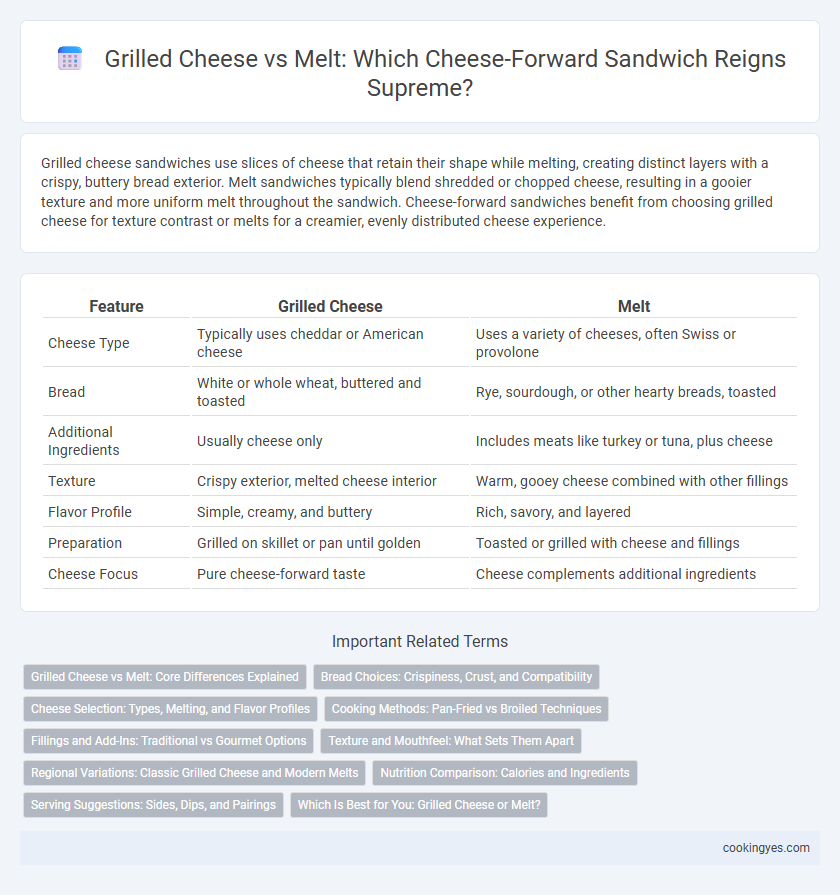Grilled cheese sandwiches use slices of cheese that retain their shape while melting, creating distinct layers with a crispy, buttery bread exterior. Melt sandwiches typically blend shredded or chopped cheese, resulting in a gooier texture and more uniform melt throughout the sandwich. Cheese-forward sandwiches benefit from choosing grilled cheese for texture contrast or melts for a creamier, evenly distributed cheese experience.
Table of Comparison
| Feature | Grilled Cheese | Melt |
|---|---|---|
| Cheese Type | Typically uses cheddar or American cheese | Uses a variety of cheeses, often Swiss or provolone |
| Bread | White or whole wheat, buttered and toasted | Rye, sourdough, or other hearty breads, toasted |
| Additional Ingredients | Usually cheese only | Includes meats like turkey or tuna, plus cheese |
| Texture | Crispy exterior, melted cheese interior | Warm, gooey cheese combined with other fillings |
| Flavor Profile | Simple, creamy, and buttery | Rich, savory, and layered |
| Preparation | Grilled on skillet or pan until golden | Toasted or grilled with cheese and fillings |
| Cheese Focus | Pure cheese-forward taste | Cheese complements additional ingredients |
Grilled Cheese vs Melt: Core Differences Explained
Grilled cheese sandwiches feature melted cheese between two buttered, toasted bread slices, offering a crispy texture and rich, gooey filling. Melt sandwiches combine melted cheese with additional savory ingredients like meats or vegetables, creating a heartier and more complex flavor profile. The core difference lies in grilled cheese emphasizing simplicity and cheese purity, while melts highlight layered components alongside the cheese.
Bread Choices: Crispiness, Crust, and Compatibility
Grilled cheese sandwiches benefit from sturdy, thick-sliced breads like sourdough or artisan white that deliver a crispy crust and strong structure to hold melting cheese without sogginess. Melt sandwiches often use softer breads such as rye or whole wheat, which complement gooey cheese blends while offering a tender bite and balanced crispiness. Selecting bread with a golden, well-toasted crust enhances the flavor profile and prevents the sandwich from becoming overly greasy or falling apart.
Cheese Selection: Types, Melting, and Flavor Profiles
Grilled cheese sandwiches shine with semi-hard cheeses like cheddar, gouda, and fontina, which offer excellent melting properties and rich, sharp flavors that create a creamy, gooey texture. Melt sandwiches often incorporate softer, melt-friendly cheeses such as Swiss, provolone, or mozzarella, known for their smooth melt and mild, buttery taste that balances savory fillings. Selecting cheeses based on meltability and flavor intensity enhances the overall taste experience by providing the ideal texture and complementing the sandwich ingredients.
Cooking Methods: Pan-Fried vs Broiled Techniques
Grilled cheese sandwiches achieve a crispy, golden-brown crust through pan-frying, allowing the cheese to melt gradually and evenly within toasted bread. Melt sandwiches utilize broiling, which rapidly heats the cheese until bubbly and slightly browned, creating a gooey and rich texture atop the sandwich. Each method emphasizes different textures and cheese melting qualities, with pan-frying offering a balanced crunch and slow melt, while broiling delivers intense heat and a more pronounced cheese browning.
Fillings and Add-Ins: Traditional vs Gourmet Options
Grilled cheese sandwiches typically feature classic fillings like cheddar, American, or Swiss cheeses, often paired with simple add-ins such as tomato or bacon, emphasizing a straightforward, melty cheese experience. Melt sandwiches expand on this foundation by incorporating gourmet fillings like smoked gouda, brie, or fontina, complemented by sophisticated add-ins such as caramelized onions, roasted peppers, arugula, or specialty mustards, offering complex layers of flavor. The choice between traditional and gourmet options significantly influences texture and taste, creating distinct cheese-forward sandwich profiles.
Texture and Mouthfeel: What Sets Them Apart
Grilled cheese sandwiches offer a crispy, golden-brown crust with a gooey, melted interior that provides a satisfying contrast in texture. Melt sandwiches typically feature a softer, toasted bread with cheese evenly melted throughout, creating a creamier, more uniform mouthfeel. The distinct crunch of grilled cheese enhances the sensory experience, while melts emphasize smoothness and cheese integration.
Regional Variations: Classic Grilled Cheese and Modern Melts
Classic grilled cheese sandwiches, popular in the Midwest and Northeast United States, feature simple combinations of American or cheddar cheese melted between toasted white or sourdough bread, emphasizing creamy texture and nostalgic comfort. Modern melts, favored in coastal regions like California and New York, incorporate diverse cheeses such as Gruyere, fontina, or blue cheese with additions like caramelized onions or smoked meats, creating complex flavor profiles and gourmet appeal. Regional variations highlight traditional simplicity in classic grilled cheese, while modern melts showcase innovation and ingredient diversity, reflecting evolving culinary trends in cheese-forward sandwiches.
Nutrition Comparison: Calories and Ingredients
Grilled cheese sandwiches typically contain fewer calories than melt sandwiches due to their simpler ingredient list, primarily bread, cheese, and butter or margarine. Melt sandwiches often include additional proteins like ham or turkey and extra toppings, which increase calorie content and add more varied nutrients such as protein and sodium. Choosing between grilled cheese and melt sandwiches depends on dietary goals, balancing caloric intake with ingredient preferences.
Serving Suggestions: Sides, Dips, and Pairings
Grilled cheese sandwiches pair excellently with classic sides like tomato soup, pickles, and crispy kettle chips, enhancing the crunchy, buttery exterior. Melts, often loaded with meats and veggies, complement creamy dips such as mustard aioli or horseradish sauce, balancing the rich, gooey cheese. Both sandwiches benefit from fresh accompaniments like crisp salads or tangy coleslaw to offset their indulgent flavors.
Which Is Best for You: Grilled Cheese or Melt?
Grilled cheese sandwiches feature toasted bread with melted cheese, creating a crispy exterior and gooey interior ideal for classic comfort. Melts combine cheese with additional fillings like meats or vegetables, offering a heartier, more complex flavor profile suitable for those seeking variety. Choosing between grilled cheese or a melt depends on your preference for simplicity versus a robust, multi-ingredient sandwich experience.
Grilled Cheese vs Melt for cheese-forward sandwiches Infographic

 cookingyes.com
cookingyes.com